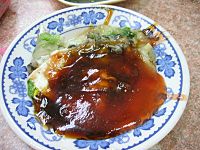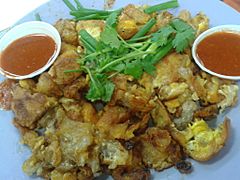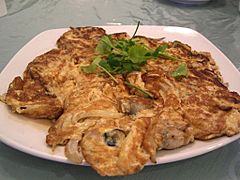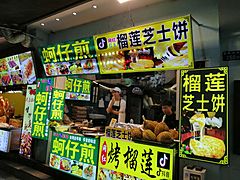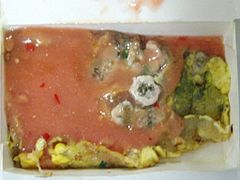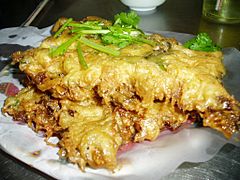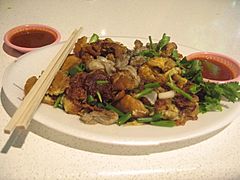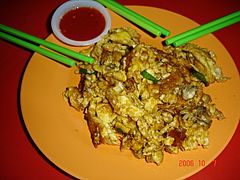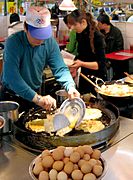Oyster omelette facts for kids
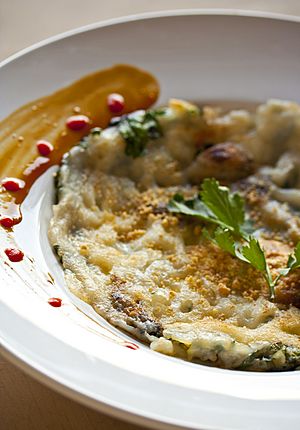 |
|
| Course | Breakfast, lunch, and dinner |
|---|---|
| Place of origin | Banlam and Teoswa, China |
| Created by | Banlamese people (Hokkien and Teochew people) |
The oyster omelette is a super popular and tasty dish. It's also known as o-a-tsian or orh luak in different places. This yummy food comes from the Banlamese people in China, including the Hokkien and Teochew people.
It's famous for its savory flavor in its home regions like Minnan region and Chaoshan in China. You can also find it in Taiwan and many parts of Southeast Asia. Countries like the Philippines, Thailand, Malaysia, and Singapore enjoy it a lot. This is because many Banlamese people moved to these areas and shared their food.
Contents
What is an Oyster Omelette?
The oyster omelette is a favorite at night markets in Taiwan. Many visitors say it's one of the best dishes from Taiwan. It's known for being a big meal that doesn't cost too much, which is common for night market foods. In the Philippines, people sometimes call it "oyster cake" on English menus.
What's in It?
This dish is an omelette filled mainly with small, fresh oysters. To make the omelette thicker, a special starch, usually sweet potato starch, is mixed into the egg batter. Cooks often use pork lard to fry the omelette, which gives it a rich flavor.
After cooking, a savory sauce might be poured over the ome omelette. This adds even more taste. Sometimes, a spicy chili sauce mixed with lime juice is added for an extra kick. If you don't like oysters, shrimp can be used instead! When made with shrimp, it's called a shrimp omelette (蝦仁煎).
Different Names
The oyster omelette has different names depending on where you are in the world. For example:
- In the Chaoshan region of China, and in communities connected to it, it's called Háo lào (蠔烙).
- In Southern Fujian, Taiwan, and the Philippines, it's often called Ô-á-chian (蚵仔煎).
- In Malaysia, Singapore, and the Philippines, you might hear it called Ô-chian (蚵煎).
- In Hong Kong and Macau, it can be known as Jīn hòuh béng (煎蠔餠) or Hòuh jái béng (蠔仔餠).
Oyster Omelette in Thailand
In Thailand, the oyster omelette is known as Hoi Thod (Thai: หอยทอด). It's often made with mussels instead of oysters, and then it's called Hoi Mleang Phu Thod (Thai: หอยแมลงภู่ทอด). The original oyster version, Hoi Nang Rom Thod (Thai: หอยนางรมทอด), is also common but usually costs more.
In Bangkok, you can find famous oyster omelettes in places like Talat Wang Lang and the Yaowarat neighborhood. In 2017, the World Street Food Congress said that the oyster omelette is one of the top three street foods in Thailand.
Gallery
See also
 In Spanish: Tortilla de ostra para niños
In Spanish: Tortilla de ostra para niños


